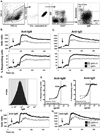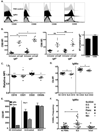Anergic responses characterize a large fraction of human autoreactive naive B cells expressing low levels of surface IgM
- PMID: 21398610
- PMCID: PMC3095097
- DOI: 10.4049/jimmunol.1001946
Anergic responses characterize a large fraction of human autoreactive naive B cells expressing low levels of surface IgM
Abstract
B cell anergy represents an important mechanism of peripheral immunological tolerance for mature autoreactive B cells that escape central tolerance enforced by receptor editing and clonal deletion. Although well documented in mice, the extent of its participation in human B cell tolerance remains to be fully established. In this study, we characterize the functional behavior of strictly defined human naive B cells separated on the basis of their surface IgM (sIgM) expression levels. We demonstrate that cells with lower sIgM levels (IgM(lo)) are impaired in their ability to flux calcium in response to either anti-IgM or anti-IgD cross-linking and contain a significantly increased frequency of autoreactive cells compared with naive B cells with higher levels of sIgM. Phenotypically, in healthy subjects, IgM(lo) cells are characterized by the absence of activation markers, reduction of costimulatory molecules (CD19 and CD21), and increased levels of inhibitory CD22. Functionally, IgM(lo) cells display significantly weaker proliferation, impaired differentiation, and poor Ab production. In aggregate, the data indicate that hyporesponsiveness to BCR cross-linking associated with sIgM downregulation is present in a much larger fraction of all human naive B cells than previously reported and is likely to reflect a state of anergy induced by chronic autoantigen stimulation. Finally, our results indicate that in systemic lupus erythematosus patients, naive IgM(lo) cells display increased levels of CD95 and decreased levels of CD22, a phenotype consistent with enhanced activation of autoreactive naive B cells in this autoimmune disease.
Figures





References
-
- Goodnow CC, Adelstein S, Basten A. The need for central and peripheral tolerance in the B cell repertoire. Science. 1990;248:1373–1379. - PubMed
-
- Hartley SB, Crosbie J, Brink R, Kantor AB, Basten A, Goodnow CC. Elimination from peripheral lymphoid tissues of self-reactive B lymphocytes recognizing membrane-bound antigens. Nature. 1991;353:765–769. - PubMed
-
- Roark JH, Bui A, Nguyen KA, Mandik L, Erikson J. Persistence of functionally compromised anti-double-stranded DNA B cells in the periphery of non-autoimmune mice. Int. Immunol. 1997;9:1615–1626. - PubMed
Publication types
MeSH terms
Substances
Grants and funding
LinkOut - more resources
Full Text Sources
Research Materials

